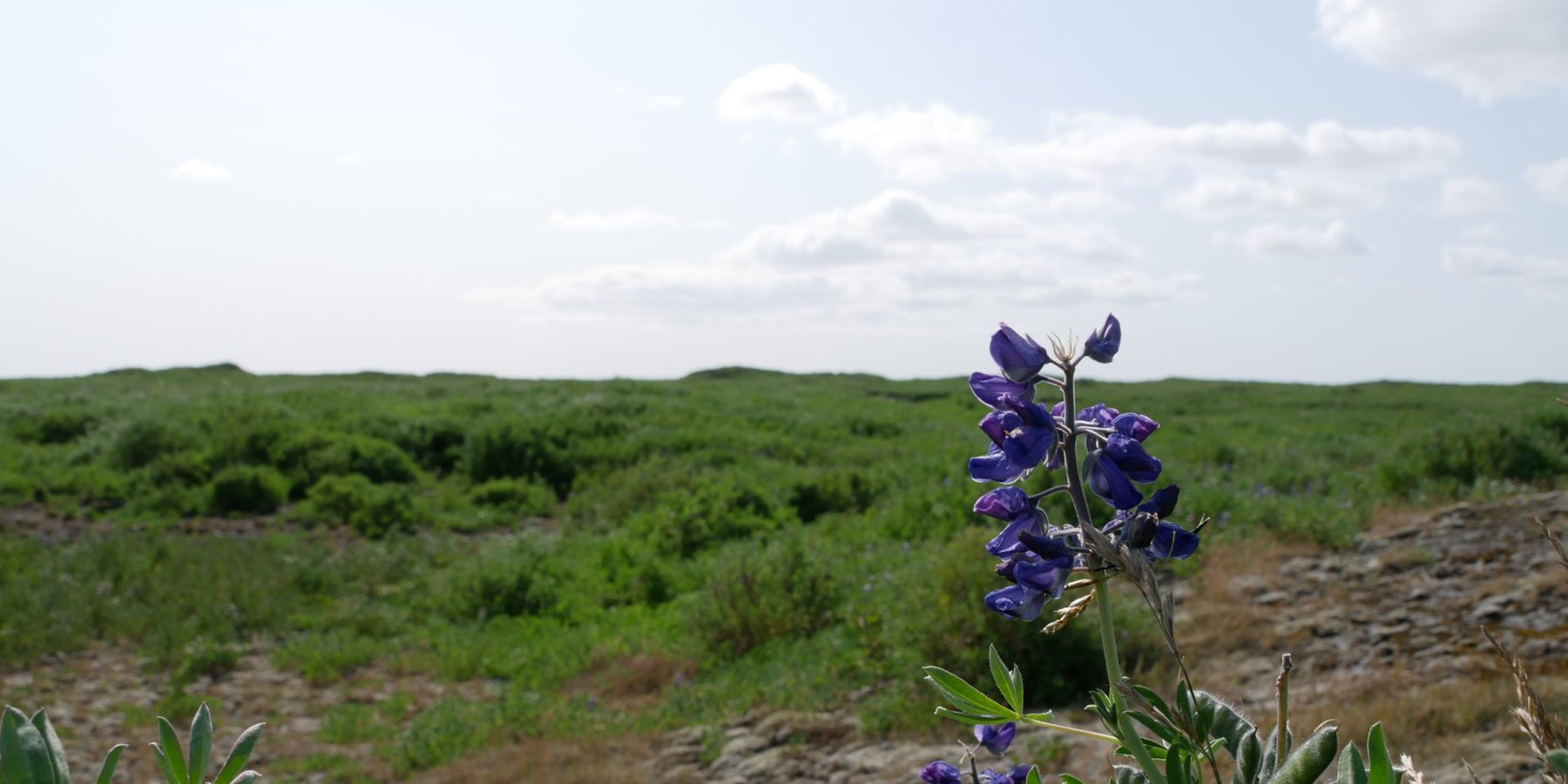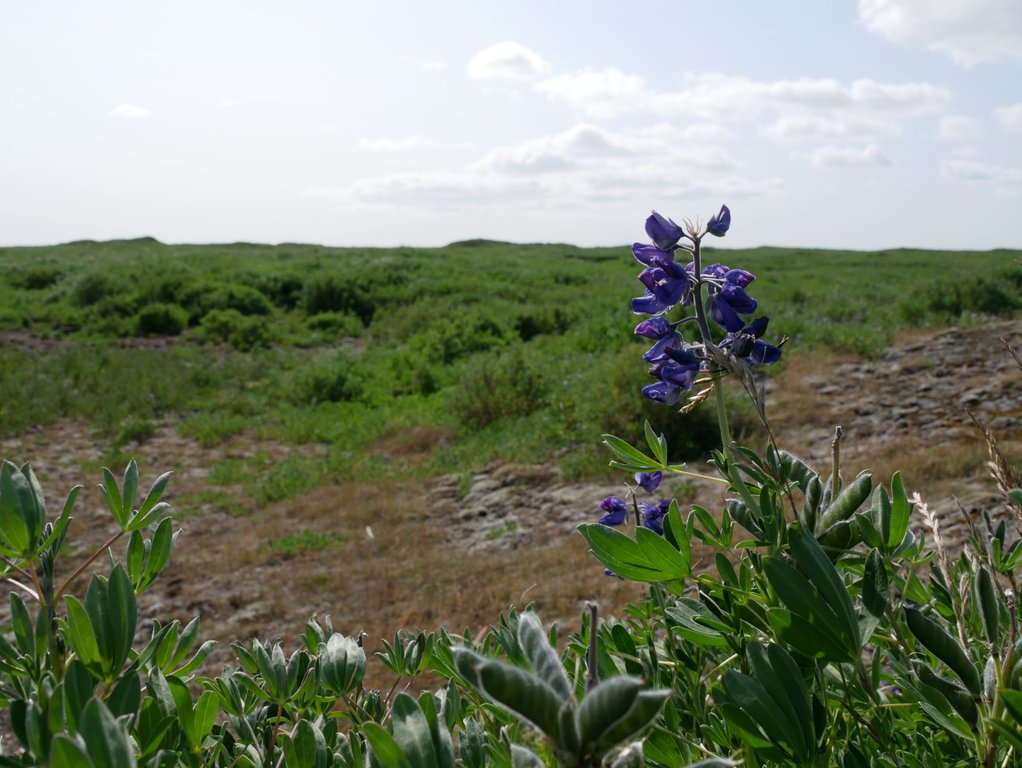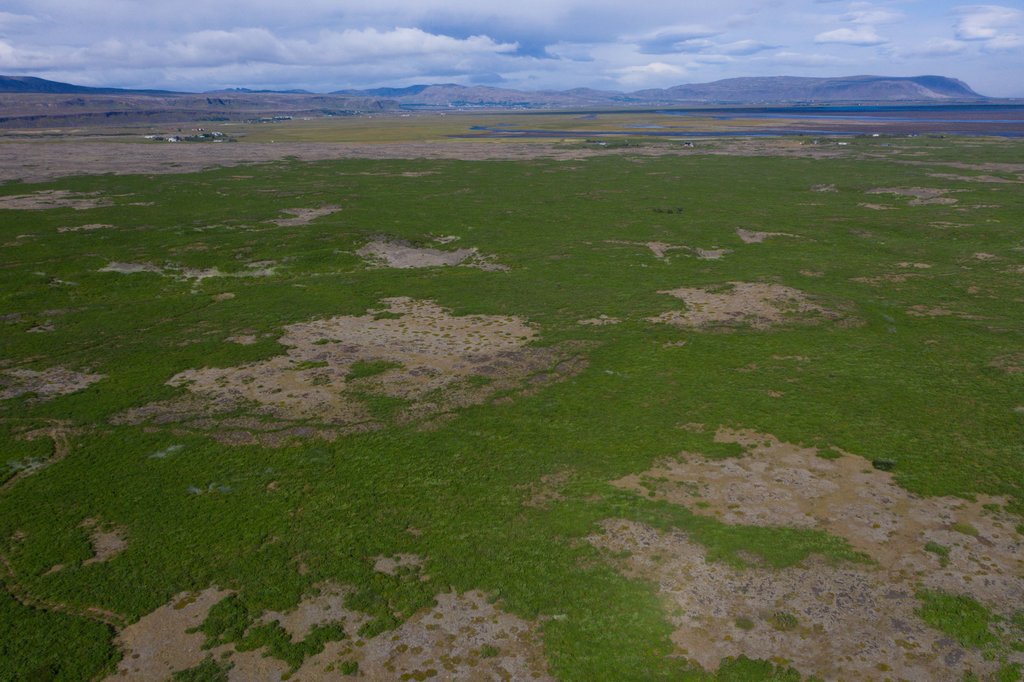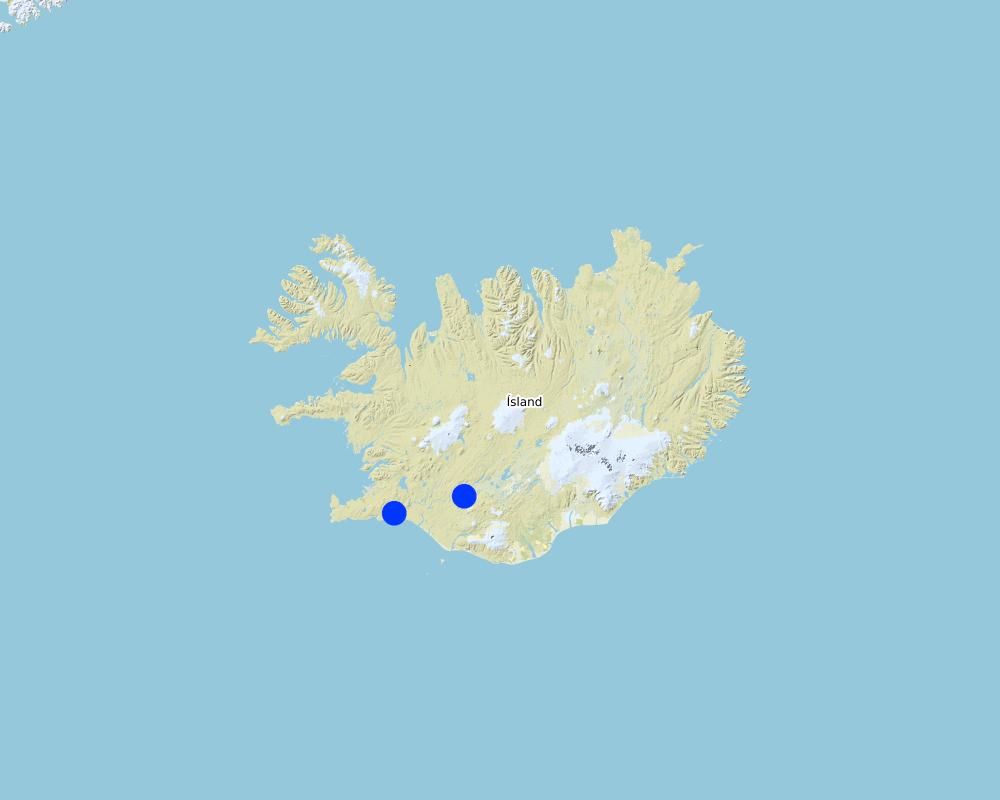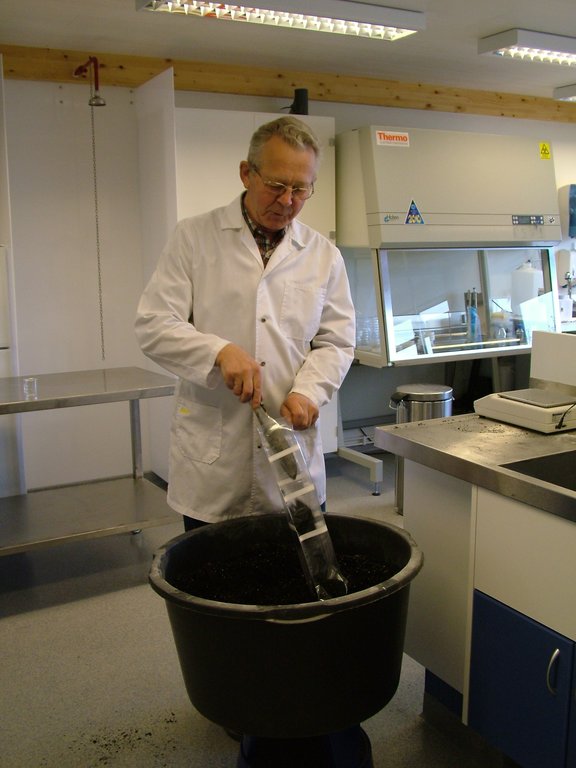Seeding lupine for land reclamation and to protect the soil against wind erosion [Iceland]
- Creation:
- Update:
- Compiler: Jan Reichert
- Editor: Hanspeter Liniger
- Reviewer: Hanspeter Liniger
Nootka lupine or Alaska lupine
technologies_5750 - Iceland
View sections
Expand all Collapse all1. General information
1.2 Contact details of resource persons and institutions involved in the assessment and documentation of the Technology
Key resource person(s)
SLM specialist:
Runólfsson Sveinn
Soil Conservation Service of Iceland
Iceland
1.3 Conditions regarding the use of data documented through WOCAT
The compiler and key resource person(s) accept the conditions regarding the use of data documented through WOCAT:
Yes
2. Description of the SLM Technology
2.1 Short description of the Technology
Definition of the Technology:
The nootka lupine is sown in sandy and gravelly areas to increase the vegetation cover and fertilize the soil.
2.2 Detailed description of the Technology
Description:
The nootka lupine (Lupinus nootkatensis) is a legume that can survive in the harsh climate of Iceland. It was introduced from Alaska to increase soil cover and fertilize the sandy and gravelly soil. For that purpose, it has been widely used from 1990 onwards in degraded areas all over Iceland. Because of its large amount of seed production, the plant is able to reproduce rapidly and spread. The ability of the lupine to fix nitrogen through its root system reduces the need for fertilizer - especially when planting trees. Increased vegetation cover due to the lupine plants minimizes vulnerability to wind erosion. The ground is protected and sandstorms can be reduced. This also protects neighbouring fields, and public and private infrastructure from sand and dust storms.
The lupine is seeded with machinery in spring or very late autumn. It is planted in strips – rather than all over the ground - because the plant readily spreads and colonise. Before planting, lupine seed have to be inoculated with rhizobium bacteria. These bacteria help the plant to fix nitrogen: without this inoculation the plant wouldn’t survive in the bare soil. These bacteria are produced during winter time in a laboratory. The lupine needs no fertilizer after planting. Planting of lupine is an extremely cost-efficient and effective way of increasing soil cover and soil fertility. It is a one-off operation: no further action needs to be carried out afterwards.
However, the nootka lupin is very controversial in Iceland despite its apparent advantages both on and offsite. The use of lupines should be carefully considered, especially in sensitive and protected areas. The reason is that this non-native plant is very invasive and leads to the displacement of the native vegetation. Grazing does not stop lupines spreading: only young plants are eaten by sheep, but once mature, its bitterness renders it unpalatable. On a small-scale, it is possible - with great effort - to slow down the spread by cutting the flowers. On a large-scale, the spread can only be stopped with herbicides which is highly controversial. From the land user’s view, the planting of lupine reduces the aesthetic value of the landscape because of monoculture: diversity is lost. That is why people try to plant trees in such fields. Because of the controversy surrounding the plant, the technology has been little adopted by farmers and due to its invasiveness, the Soil Conservation Service stopped using the lupine in 2018.
2.3 Photos of the Technology
2.5 Country/ region/ locations where the Technology has been applied and which are covered by this assessment
Country:
Iceland
Region/ State/ Province:
South of Iceland
Further specification of location:
Thorlákshöfn, Hekla area
Specify the spread of the Technology:
- evenly spread over an area
If precise area is not known, indicate approximate area covered:
- 10-100 km2
Is/are the technology site(s) located in a permanently protected area?
No
Map
×2.6 Date of implementation
If precise year is not known, indicate approximate date:
- 10-50 years ago
2.7 Introduction of the Technology
Specify how the Technology was introduced:
- during experiments/ research
- through projects/ external interventions
3. Classification of the SLM Technology
3.1 Main purpose(s) of the Technology
- reduce, prevent, restore land degradation
- reduce risk of disasters
3.2 Current land use type(s) where the Technology is applied
Land use mixed within the same land unit:
No

Grazing land
Extensive grazing:
- Ranching
Intensive grazing/ fodder production:
- Cut-and-carry/ zero grazing
Animal type:
- horses
- sheep
Products and services:
- meat
- whool

Unproductive land
Specify:
eroded land, degraded land
3.3 Has land use changed due to the implementation of the Technology?
Has land use changed due to the implementation of the Technology?
- Yes (Please fill out the questions below with regard to the land use before implementation of the Technology)

Unproductive land
Specify:
Lupine is to bitter for sheep. That's why the land can't be grazed.
3.4 Water supply
Water supply for the land on which the Technology is applied:
- rainfed
3.5 SLM group to which the Technology belongs
- improved ground/ vegetation cover
- ecosystem-based disaster risk reduction
3.6 SLM measures comprising the Technology

vegetative measures
- V2: Grasses and perennial herbaceous plants
Comments:
Can be combined with birch tree planting.
3.7 Main types of land degradation addressed by the Technology

soil erosion by wind
- Et: loss of topsoil
- Ed: deflation and deposition
- Eo: offsite degradation effects
3.8 Prevention, reduction, or restoration of land degradation
Specify the goal of the Technology with regard to land degradation:
- reduce land degradation
- restore/ rehabilitate severely degraded land
4. Technical specifications, implementation activities, inputs, and costs
4.1 Technical drawing of the Technology
Technical specifications (related to technical drawing):
Lupine seeds are being inoculated with rhizobium bacteria prior to seeding. These bacteria help the plant to fix nitrogen. Without this inoculation the Lupine wouldn’t survive in the soil.
The seeds are seeded in by machinery in stripes because the plant spreads fast itself. No fertilizer is needed. Normally 5 kg of lupine seeds per ha is used.
Author:
Sveinn Runólfsson
4.2 General information regarding the calculation of inputs and costs
Specify how costs and inputs were calculated:
- per Technology area
Indicate size and area unit:
Project costs in Thorlákshöfn
other/ national currency (specify):
ISK
If relevant, indicate exchange rate from USD to local currency (e.g. 1 USD = 79.9 Brazilian Real): 1 USD =:
138.0
4.3 Establishment activities
| Activity | Timing (season) | |
|---|---|---|
| 1. | production of bakteria in labratory at Gunnarsholt | winter |
| 2. | inoculat the seeds before seeding | spring time and very late autumn |
| 3. | seeding lupine | spring time and very late autumn |
4.4 Costs and inputs needed for establishment
| Specify input | Unit | Quantity | Costs per Unit | Total costs per input | % of costs borne by land users | |
|---|---|---|---|---|---|---|
| Other | Seeding lupine (total costs) | ha | 1.0 | 30000.0 | 30000.0 | |
| Total costs for establishment of the Technology | 30000.0 | |||||
| Total costs for establishment of the Technology in USD | 217.39 | |||||
4.5 Maintenance/ recurrent activities
Comments:
There is no recurring activity.
4.6 Costs and inputs needed for maintenance/ recurrent activities (per year)
Comments:
There is no recurring activity.
4.7 Most important factors affecting the costs
Describe the most determinate factors affecting the costs:
workers, seeds, machinery
5. Natural and human environment
5.1 Climate
Annual rainfall
- < 250 mm
- 251-500 mm
- 501-750 mm
- 751-1,000 mm
- 1,001-1,500 mm
- 1,501-2,000 mm
- 2,001-3,000 mm
- 3,001-4,000 mm
- > 4,000 mm
Agro-climatic zone
- sub-humid
- semi-arid
5.2 Topography
Slopes on average:
- flat (0-2%)
- gentle (3-5%)
- moderate (6-10%)
- rolling (11-15%)
- hilly (16-30%)
- steep (31-60%)
- very steep (>60%)
Landforms:
- plateau/plains
- ridges
- mountain slopes
- hill slopes
- footslopes
- valley floors
Altitudinal zone:
- 0-100 m a.s.l.
- 101-500 m a.s.l.
- 501-1,000 m a.s.l.
- 1,001-1,500 m a.s.l.
- 1,501-2,000 m a.s.l.
- 2,001-2,500 m a.s.l.
- 2,501-3,000 m a.s.l.
- 3,001-4,000 m a.s.l.
- > 4,000 m a.s.l.
Indicate if the Technology is specifically applied in:
- not relevant
5.3 Soils
Soil depth on average:
- very shallow (0-20 cm)
- shallow (21-50 cm)
- moderately deep (51-80 cm)
- deep (81-120 cm)
- very deep (> 120 cm)
Soil texture (topsoil):
- coarse/ light (sandy)
Soil texture (> 20 cm below surface):
- coarse/ light (sandy)
Topsoil organic matter:
- low (<1%)
5.4 Water availability and quality
Ground water table:
< 5 m
Availability of surface water:
poor/ none
Water quality (untreated):
good drinking water
Water quality refers to:
ground water
Is water salinity a problem?
No
Is flooding of the area occurring?
No
5.5 Biodiversity
Species diversity:
- low
Habitat diversity:
- low
5.6 Characteristics of land users applying the Technology
Sedentary or nomadic:
- Sedentary
Market orientation of production system:
- commercial/ market
Off-farm income:
- 10-50% of all income
Relative level of wealth:
- rich
Individuals or groups:
- groups/ community
- employee (company, government)
Level of mechanization:
- mechanized/ motorized
Gender:
- women
- men
Age of land users:
- middle-aged
5.7 Average area of land used by land users applying the Technology
- < 0.5 ha
- 0.5-1 ha
- 1-2 ha
- 2-5 ha
- 5-15 ha
- 15-50 ha
- 50-100 ha
- 100-500 ha
- 500-1,000 ha
- 1,000-10,000 ha
- > 10,000 ha
Is this considered small-, medium- or large-scale (referring to local context)?
- medium-scale
5.8 Land ownership, land use rights, and water use rights
Land ownership:
- state
- communal/ village
Land use rights:
- individual
Water use rights:
- individual
Are land use rights based on a traditional legal system?
Yes
5.9 Access to services and infrastructure
health:
- poor
- moderate
- good
education:
- poor
- moderate
- good
technical assistance:
- poor
- moderate
- good
employment (e.g. off-farm):
- poor
- moderate
- good
markets:
- poor
- moderate
- good
energy:
- poor
- moderate
- good
roads and transport:
- poor
- moderate
- good
drinking water and sanitation:
- poor
- moderate
- good
financial services:
- poor
- moderate
- good
6. Impacts and concluding statements
6.1 On-site impacts the Technology has shown
Socio-economic impacts
Water availability and quality
drinking water availability
drinking water quality
Socio-cultural impacts
health situation
Comments/ specify:
Less dust in the air during windstorms due to increased ground cover and therefore fewer health consequences.
cultural opportunities
recreational opportunities
community institutions
national institutions
SLM/ land degradation knowledge
Ecological impacts
Water cycle/ runoff
water quantity
water quality
harvesting/ collection of water
surface runoff
groundwater table/ aquifer
evaporation
Soil
soil moisture
soil cover
soil loss
nutrient cycling/ recharge
Biodiversity: vegetation, animals
Vegetation cover
biomass/ above ground C
plant diversity
Comments/ specify:
Due to its invasiveness and its enormously dense growth, other native plants are displaced by the lupine.
habitat diversity
Comments/ specify:
Due to its invasiveness and its enormously dense growth, other native plants are displaced by the lupine.
Climate and disaster risk reduction
emission of carbon and greenhouse gases
wind velocity
6.2 Off-site impacts the Technology has shown
water availability
downstream flooding
downstream siltation
groundwater/ river pollution
buffering/ filtering capacity
wind transported sediments
damage on neighbours' fields
damage on public/ private infrastructure
impact of greenhouse gases
6.3 Exposure and sensitivity of the Technology to gradual climate change and climate-related extremes/ disasters (as perceived by land users)
Climate-related extremes (disasters)
Biological disasters
| How does the Technology cope with it? | |
|---|---|
| insect/ worm infestation | moderately |
Comments:
The lupine has been infested by a larvae in recent years. However, its population has collapsed and thus shrunk considerably.
6.4 Cost-benefit analysis
How do the benefits compare with the establishment costs (from land users’ perspective)?
Short-term returns:
positive
Long-term returns:
positive
How do the benefits compare with the maintenance/ recurrent costs (from land users' perspective)?
Short-term returns:
positive
Long-term returns:
positive
6.5 Adoption of the Technology
- 1-10%
Of all those who have adopted the Technology, how many did so spontaneously, i.e. without receiving any material incentives/ payments?
- 0-10%
6.6 Adaptation
Has the Technology been modified recently to adapt to changing conditions?
Yes
other (specify):
stopp further seeding
Specify adaptation of the Technology (design, material/ species, etc.):
Due to its invasiveness in Iceland, the Soil Conservation Service of Iceland stopped using the lupine in 2018.
6.7 Strengths/ advantages/ opportunities of the Technology
| Strengths/ advantages/ opportunities in the land user’s view |
|---|
| The use of lupines is a very cost-effective application, which protects the soil well against wind erosion. |
| Strengths/ advantages/ opportunities in the compiler’s or other key resource person’s view |
|---|
| The use of lupines is a very cost-effective application, which protects the soil well against wind erosion. |
| Less artificial fertiliser has to be used because the lupine fertilizes the soil. |
| Sowing the lupine is a unique application. No further operations need to be carried out after that. |
6.8 Weaknesses/ disadvantages/ risks of the Technology and ways of overcoming them
| Weaknesses/ disadvantages/ risks in the land user’s view | How can they be overcome? |
|---|---|
| Lupine is very invasive and displaces native plants. | The use of lupines should be carefully considered. On a small scale, it is possible with great effort to slow down the spread by cutting the flowers. On a large scale, the only possibility to stop the spreading would be the use of herbicides. |
| The aesthetic value of the landscape is reduced by the monoculture of lupines. | By planting trees in the lupines the aesthetic value can be increased. |
| Weaknesses/ disadvantages/ risks in the compiler’s or other key resource person’s view | How can they be overcome? |
|---|---|
| The non-native plant is very invasive and produces large quantities of seeds why it is spreading rapidly. This leads to the displacement of the native vegetation. This can become a significant problem in protected areas (national parks). | The use of lupines should be carefully considered, especially in sensitive and protected areas. On a small scale, it is possible with great effort to slow down the spread by cutting the flowers. On a large scale, the only possibility to stop the spreading would be the use of herbicides. |
| The lupine is very invasive and spreads very quickly. | The SCS has stopped planting lupine since 2018. |
7. References and links
7.1 Methods/ sources of information
- field visits, field surveys
- interviews with land users
- interviews with SLM specialists/ experts
When were the data compiled (in the field)?
01/08/2019
7.3 Links to relevant online information
Title/ description:
Webpage Soil Conservation Service of Iceland
URL:
https://land.is/english/
Links and modules
Expand all Collapse allLinks
No links
Modules
No modules


